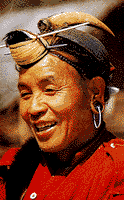ITANAGAR
The Brahmaputra draws many of its tributaries from the densely forested mountains of Arunachal; the Siang, the Dibang, the
Lohit and the Noa Dihing are some of the rivers which drain the rain from some of
Arunachal's northern and eastern ranges and pour them into Brahamputra. The Subansiri and
the Bharali perform similar duties for the south.
tributaries from the densely forested mountains of Arunachal; the Siang, the Dibang, the
Lohit and the Noa Dihing are some of the rivers which drain the rain from some of
Arunachal's northern and eastern ranges and pour them into Brahamputra. The Subansiri and
the Bharali perform similar duties for the south.
The interpid explorer can paddle up these rivers and journey...if he has not been deterred
by falls and rapids on the way...as far as China, where the Siang begins, if he trusts the
roads, he will be able to reach the headquarters of the ten districts, but not very much
further.
No railway enters Arunachal. But Indian
Airlines and Alliance Airlines do serve Tezu, Ziro and Pasighat. It's, in other words, India's
largest north-eastern state, and also its remotest. And this is the beauty and the wonder
and the compelling fascination of unknown Arunachal Pradesh.
But on the two hour journey from the
airport in Lilabari, Assam, to the capital of Naharlagun(Itanagar), the fascination grows
slowly. Lilabari is a plains town and Naharlagun gives the impression of a plains town.
But the 10 km drive from the 200 metre high Naharlagun to the new capital in the hills,
Itanagar at 750 metres, is enchanting.
The road winds through that magical
country where tropical evergreen rain forests meet temperate Himalayan jungles. Tree ferns
spread their greenfronds to great heights; jungle giants tower into the sky; there are
burgeoning thickets of bamboo; and thick mats of creepers cover everything with undulating
bedspreads of green.
The visitor should stop at the far side
of the bridge that spans the Pachim River. There is an attractive village below and
to the right of the road leading to Itanagar. Most of the houses are built at ground level
but at least one is on stilts. Such variations could be the result of cross-cultural
influences between the twenty major tribes who speak many different languages. According
to one account of some of these varied people: There are the gently and cultured Monpas of
West Kameng who received Buddhism from Padma Sambhava; the Thongi (Sherdukpens) whoes
chiefs trace their treaty relationships with the powers in the valley to a thousand years
back; the Hrusso who for thirty generations have patronised Vaishnava scholars; the proud
Bangni-Nishi and the Tagin typifying the ancient Indian ideal of the honourable warrior;
the Adis and Mishmis who are eager to build academic careers; the Apatanis with their
marvels of wet-rice cultivation; the Khampti in their magnificent ceremonial robes and the
peaceful, progressive Nocte, Wancho and Tangsa.
The people of Arunachal are the greatest
attraction of this beautiful land. And even in the capital at
Itanagar, the visitor comes across Nishi warriors wearing their 'bopiah' hornbill caps,
carrying their 'chokh' bearskin bags with their 'oyjo' knives in their monkey-skin
'burkhey' scabbards. But the visitor should not be misled by their appearance.
As a community's level of civilisation is
judged by its health, its urge to fulfil its social responsibilities and its emotional
stability, the tribals of Arunachal Pradesh are highly civilised. According to Dr. Parul
Dutta, Director in the Tribal Culture Research Department , the tribes are in good health
and well-nourished, there are no land disputes, and when an entire village burns down the
whole community gets together and with great good cheer, rebuilds it as a community
effort. Administrators who have worked in this state contend that in spite of the fact
that the police have jurisdiction for only 5 kms. around the District Headquarters, crimes
in villages can be concealed for only three days because the prople are virtually
incapable of telling lies and they have very clear ideas of justice.
These, then, are in unspoilt people of
Arunachal. And in dealing with them, the Government of India has taken the words of
Jawaharlal Nehru to heart. India's first Prime Minister said: "I felt that we should
avoid two extreme courses, one was to treat them as anthropological specimens for study
and the other was to allow them to be engulfed by masses of India's humanity... We must
always remember that we do not mean to interfere with their way of life but want to help
them live it".
Itanagar captures the spirit of this
desire to minimise the conflicts that arise when a traditional society is guided into
modernity.
The capital is a scatter of light,
earthquake-proof, woodframe buildings rising up the slopes of a green hill. Traditional
huts are scattered amongst the more recent constructions and the residence of the Lt.
Governor crowns one peak while a new Buddhist temple crowns the other. Between them lie
the administrative offices, shops, the bazar and thatched huts.
It's all very low-profile and unassuming
and even the most diffident tribal from the remotest village is unlikely to feel uneasy
when he comes to the capital.
Thus, when the visitor decides to visit
this town he should realise that there is a very good reason for such a frontier state to
have such a frontier town as its capital: Itanagar.
Itanagar has been identified with
Mayapur, the capital of the 11th century AD Jitri dynasty.
|
